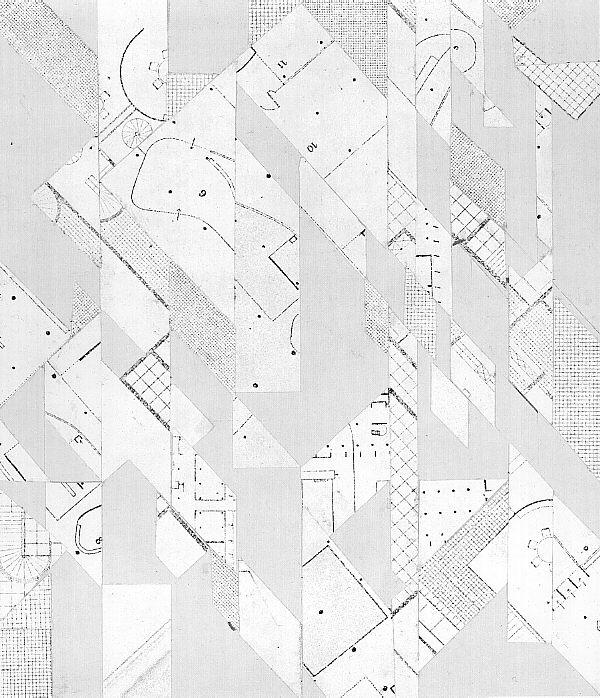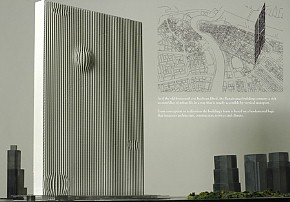Collage challenges the notion of architecture as a synthetic construct--a mixture of various creative disciplines. The idea of achieving such a synthesis by a hollow manipulation of heterogeneous elements can result only in 'synthetic flaws'. Architecture cannot compete with film, total theater, technology, psychology, or sociology, to achieve relevance. By drawing from these motley disciplines it constructs only hybrid conglomerations without integral syntactic necessity or organic unity. The expedient definition of architecture as a 'total environmental system' is popular among designers, users, producers, critics, etc., because it allows the concurrence of all these points of view without provoking a conflict between them. The theory that architecture is a synthesis along Wagner's theory of the theater, allows and in turn justifies, the complete exploitation of any devise; be it plastic, programmatic, or technical, in order to achieve a superficial stimulation of our sensibilities. In this way the accidental and arbitrary parade in the guise of a new methodology. The attempt at incorporating these foreign technologies or sophisticated mechanizations does not lead to dynamism of thought but rather to enervating physical mobility. Progress in this direction is therefore futile from the conceptual view, for no matter how much architecture exploits these resources, it will always remain inferior to a discipline such as film, for its ability to manipulate sequences, control speed, or create instantaneousness.
The analytic approach, devoid of multiple means, limited to the existing materials, determined by historical realities, can fashion a new framework for concepts and ideas by releasing us from the determinism in both syntactic and semantic domains. It is a kind of poverty that is being proposed. A poverty of matter to be compensated by the development of the conceptual ideal. The use of 'garbage' reveals a possible method which can penetrate beyond the surface appearance of meaning and form, and strike at the very depth of conditioned relations; generating through a new grammar radically different ways of perceiving, thinking, and ultimately perhaps acting. [c 1969]

circa 1969 published within Education of an Architect, 1971

circa 1969 published within Education of an Architect, 1971

circa 1969 published within Education of an Architect, 1971

circa 1969 published within Education of an Architect, 1971

circa 1969 published within Education of an Architect, 1971
| |

circa 1969 published within Education of an Architect, 1971

circa 1969 published within Education of an Architect, 1971
see 3208
2003.09.09 20:01
Re: marshall berman: rebuilding meaning
It's interesting how Berman's "Rebuilding Meaning" is all about Libeskind the person, and contains virtually nothing about the proposed design for Ground Zero. I suppose that's indicative of just another form of (professorial) gimmickry, as in "rebuilding the meaning of Libeskind."
Or is "Rebuilding Meaning" really just a propaganda shoe that fits because the foot has been forgotten?
2005.05.07 10:18
Trump vs. Libeskind
In all fairness, let's at least admit that Libeskind's name too was very much affixed all over the first Freedom Tower design.
2007.10.27 13:40
Collage Architecture
I remember those collages in Education of an Architect I from back in the mid-1970s; had no idea who did them back then, and vaguely recall later learning they were by Libeskind. I could probably find some very old "xerox" copies if I looked hard enough. Now, in retrospect, I'd say they had a strong, albeit subliminal, influence on some of my operations. And add to that an early CAD training (1983), the whole 'cut and paste' ethos of computer processing, along with the overall ease of data manipulation, then opened a whole new field with respect to architectural drawing.

2012.10.31 11:43
atemporality at work?
Do precedents and/or antecedents work against the notion of atemporality?
As much as I like the collages of Archive of Affinities, I am, at the same time, not prepared to fully explain why I like them nor what it is exactly about the collages that I like so much. Varnelis' description of the collages as "atemporality at work" is indeed intriguing, and I want to know more. Consequently thinking for myself, it is the search for and research of the precedents and antecedents that provide a context for a better understanding of the collages of Archive of Affinities.
Anecha, a fellow admirer of the collages of Archive of Affinities, feels the "recent work may not be postmodern in the design sense, in the sense of a particular style, it is explicitly postmodern in methodology and ideology. Postmodernism didn't stop because people stopped believing in it: as Lethem notes, 'the tools that postmodernism left us have entered mainstream usage, they are free to become distinct from any style.' Ultimately postmodernism is the framework in which creators have been, and are still operating." I suppose the question is: How do these new collages from Archive of Affinities operate? And from what context do they operate?
Interestingly, the words a-temporality and a-temporal make an appearance within the text of Collage City:
"Presented with Marinetti's chronolatry and Picasso's a-temporality; presented with Popper's critique of historicism (which is also Futurism/futurism); presented with the difficulties of both utopia and tradition, with the problems of both violence and atrophy; presented with alleged libertarian impulse and alleged need for the security of order; presented with the sectarian tightness of the architect's ethical corset and with more reasonable visions of catholicity; presented with contraction and expansion; we ask what other resolution of social problems is possible outside the, admitted, limitations of collage. Limitations which should be obvious enough; but limitations which still prescribe and assure an open territory."
"Excursus: We append an abridged list of stimulants, a-temporal and necessarily transcultural, as possible objets trouvés in the urbanistic collage."
...the Basilica of St. Stefano, Bologna, thirteenth century, a religious compound where the Court of Pilate and the Church of the Holy Sepulcher, Jerusalem were/are specifically reenacted.

1. The six churches of which the plans are here given, nos. 1 to 6, are thus grouped at Bologna, under the title St. Stephen, the church no. 1, however, being more particularly dedicated to the saint.
2. Subterranean Church of S. Lorenzo, beneath that of St. Stephen, and serving as the Confession.
3. Church of the Holy Sepulchre; according to tradition the baptistery of St. Peter and St. Paul, no. 6, the first cathedral built at Bologna.
4. Another church, called the Court of Pilate.
5. Church of the Trinity.
6. Church of St. Peter and St. Paul.
COLLAGE/DANIEL LIBESKIND. Collage challenges the notion of architecture as a synthetic construct--a mixture of various creative disciplines. The idea of achieving such a synthesis by a hollow manipulation of heterogeneous elements can result only in 'synthetic flaws'. Architecture cannot compete with film, total theater, technology, psychology, or sociology, to achieve relevance. By drawing from these motley disciplines it constructs only hybrid conglomerations without integral syntactic necessity or organic unity. The expedient definition of architecture as a 'total environmental system' is popular among designers, users, producers, critics, etc., because it allows the concurrence of all these points of view without provoking a conflict between them. The theory that architecture is a synthesis along Wagner's theory of the theater, allows and in turn justifies, the complete exploitation of any devise; be it plastic, programmatic, or technical, in order to achieve a superficial stimulation of our sensibilities. In this way the accidental and arbitrary parade in the guise of a new methodology. The attempt at incorporating these foreign technologies or sophisticated mechanizations does not lead to dynamism of thought but rather to enervating physical mobility. Progress in this direction is therefore futile from the conceptual view, for no matter how much architecture exploits these resources, it will always remain inferior to a discipline such as film, for its ability to manipulate sequences, control speed, or create instantaneousness. The analytic approach, devoid of multiple means, limited to the existing materials, determined by historical realities, can fashion a new framework for concepts and ideas by releasing us from the determinism in both syntactic and semantic domains. It is a kind of poverty that is being proposed. A poverty of matter to be compensated by the development of the conceptual ideal. The use of 'garbage' reveals a possible method which can penetrate beyond the surface appearance of meaning and form, and strike at the very depth of conditioned relations; generating through a new grammar radically different ways of perceiving, thinking, and ultimately perhaps acting. [c 1969]

Exodus, or the Voluntary Prisoners of Architecture
This study describes the steps that will have to be taken to establish an architectural oasis in the behavioral sink of London.
Suddenly, a strip of intense metropolitan desirability runs through the center of London. This strip is like a runway, a landing strip for the new architecture of collective monuments. Two walls enclose and protect this zone to retain its integrity and to prevent any contamination of its surface by the cancerous organism that threatens to engulf it.
Soon, the first inmates beg for admission. Their number rapidly swells into an unstoppable flow.
We witness the Exodus of London.
The physical structure of the old town will not be able to stand the continuing competition of this new architectural presence. London as we know it will become a pack of ruins.

Rem Koolhaas, Madelon Vreisendorp, Elia Zenghelis, Zoe Zenghelis, 1971.
2012.12.24 17:08
23 December
[Divine Comedy,] Terragni, Hejduk, Eisenman, Koolhaas, (via extruded collages) Libeskind, c. 1970


Quondam 2012 digitally spiced up:

2013.03.13 20:01
13 March
Noticed a provocative similarity between one the collages produced by Libeskind* while a student at Cooper Union (c. 1969) and the plan for La Villette by Koolhaas and Zenghelis (1982).


Provocative in the sense of now mentally overlapping the two design strategies, kind of like dimensionally enhancing the already multiple choices.
*Libeskind uses bits of Barcelona Pavilion, Tugendhat House (both Mies), Carpenter Center, Palais des Congres (both Le Corbusier).
2013.03.14 11:58
13 March
Coincidently read this in The Autopoiesis of Architecture early this morning:
"...and Rem Koolhaas's Delirious New York celebrating Manhattan's 'culture of congestion' and its 'critical paranoid method' of radical programmatic and stylistic juxtaposition. The phenomena that Koolhaas found in New York--congestion and random juxtaposition--were violating the prevailing Modernist principles." (p. 130)
It seems that "congestion and random juxtaposition--were violating the prevailing Modernist principles" could be said for Libeskind's collage as well.
Maybe later today I'll take the La Villette plan and cut-and-paste it like a Libeskind collage.
While thinking of all this, I was reminded of something I wrote 2004.05.18 (for sure subliminally influenced by Koolhaas): "I like the list; like chapters, like lessons, like evolutionary stages, like different floors of a building I'd love to design, like a row of restaurants while you're perpetually hungry."
And finally, like the La Villette plan is the section of the New York Athletic Club flipped down, that tower for Dubai is an older Arab settlement flipped up.


Would the Libeskind collage make for an interesting building section?
|

















